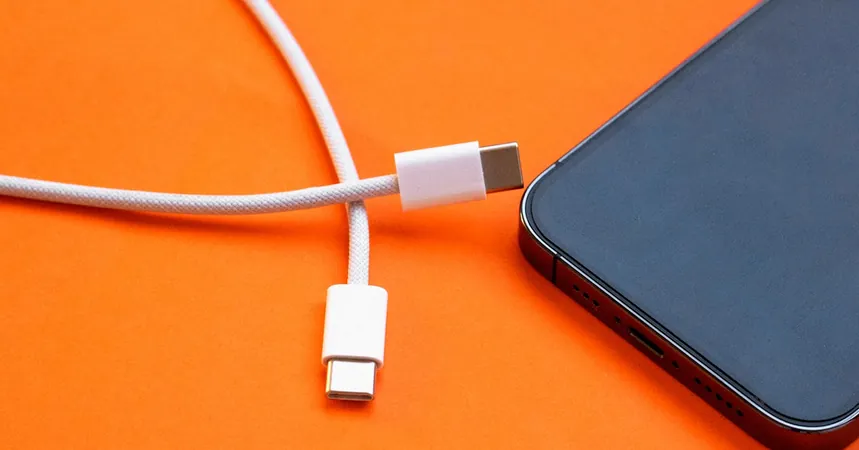
USB-C Becomes the Standard Charger Across Europe: What You Need to Know!
2025-01-03
Author: Siti
On December 28, 2024, the European Commission made a bold statement: "It's time for THE charger!" This announcement marks a significant milestone for consumers and tech enthusiasts in the European Union, as the awaited Common Charger Directive officially comes into effect. While it specifically targets the EU, the implications for tech innovation and environmental sustainability are profound.
The Common Charger Directive mandates that all "radio equipment" equipped with a rechargeable battery must now feature a USB-C receptacle. This means that devices capable of being powered through a wired connection and drawing up to 100 watts via USB-C are included under the new requirements. Even devices designed and released prior to this date must comply if they are sold after it. This extensive range of gadgets affects smartphones, tablets, handheld gaming consoles, and more, significantly reducing the clutter of various charging cables and plugs that consumers have faced for years.
One notable exception in this directive is laptops, which are granted a bit more time to adapt; they have until April 2026 to switch over to USB-C compliance. Drones currently remain outside the directive’s scope, but one can expect that the EU will eventually address this category too.
However, the regulation is not without flexibility. Devices with non-rechargeable batteries—such as certain smart home devices—or those that charge solely via wireless methods, are exempt. Additionally, there is some ambiguity regarding products that recharge within a carrying case, although cases for earbuds will still fall under the new rule, pushing companies to innovate further into USB-C compatibility.
Apple's Transformation: How the Directive Influences Tech Giants
Arguably the industry leader impacted by this directive is Apple. Known for its commitment to proprietary technology with its Lightning connector, the company has slowly embraced USB-C across its range of products. The latest iMac includes accessories like a Magic Keyboard and Magic Mouse connected through USB-C. Following the directive, Apple discontinued selling the Lightning-charging iPhone 14 and iPhone SE in the EU.
Furthermore, the directive ensures that devices offering "fast charging" capabilities (over 15 watts) must support the USB Power Delivery (USB PD) standard. This requirement aims to streamline charging experiences, allowing any compatible charger to negotiate the right power levels without relying on proprietary solutions.
In a move toward transparency, all devices sold in Europe must now clearly state on their packaging whether they come with a charging plug or brick, alongside information about their power requirements and USB PD support.
Innovations and Concerns: What Lies Ahead?
While the EU's introduction of USB-C as the primary charging method has been celebrated, it hasn't come without skepticism. Critics worry that enforcing a single charging standard may stifle innovation in alternative charging technologies. The directive, however, encompasses provisions that permit more potent devices to remain exempt, allows secondary power options, and encourages, albeit indirectly, the exploration of wireless charging solutions.
The big question remains: How will this directive be enforced across different EU nations, and will tech companies choose to strictly comply with the new rules internationally or tailor products specifically for the EU marketplace?
As Europe leads the charge toward a unified charging solution, one can't help but wonder if this standard will cascade globally, weaving a more sustainable future while simplifying life for consumers and reducing e-waste. The shift towards a universal USB-C charging standard could pave the way for a more harmonious tech ecosystem, but only time will tell. Are you ready for "THE charger"?


 Brasil (PT)
Brasil (PT)
 Canada (EN)
Canada (EN)
 Chile (ES)
Chile (ES)
 Česko (CS)
Česko (CS)
 대한민국 (KO)
대한민국 (KO)
 España (ES)
España (ES)
 France (FR)
France (FR)
 Hong Kong (EN)
Hong Kong (EN)
 Italia (IT)
Italia (IT)
 日本 (JA)
日本 (JA)
 Magyarország (HU)
Magyarország (HU)
 Norge (NO)
Norge (NO)
 Polska (PL)
Polska (PL)
 Schweiz (DE)
Schweiz (DE)
 Singapore (EN)
Singapore (EN)
 Sverige (SV)
Sverige (SV)
 Suomi (FI)
Suomi (FI)
 Türkiye (TR)
Türkiye (TR)
 الإمارات العربية المتحدة (AR)
الإمارات العربية المتحدة (AR)